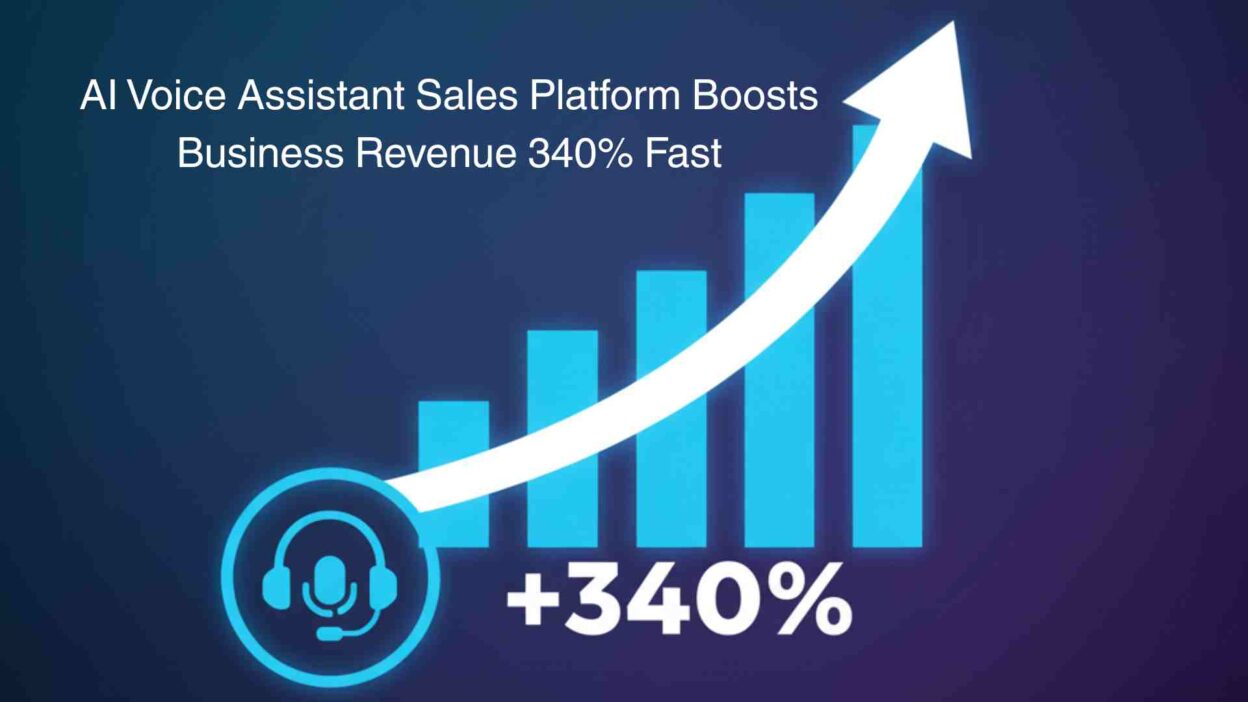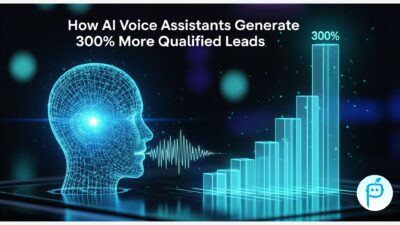Introduction
TL;DR AI voice assistant sales platform boosts business revenue by changing everything about selling products. Business owners struggle with slow response times and missed opportunities daily. Smart companies now use voice AI to talk with customers right away. This technology helps sales teams work better and close more deals fast.
Table of Contents
Why Old Sales Methods Don’t Work When an AI Voice Assistant Sales Platform Boosts Business Revenue
Sales teams face big problems with traditional approaches today. Cold calling takes too much time and energy. Most leads disappear before anyone calls them back.
The Speed Problem Kills Sales
Companies lose 80% of their leads in the first hour. People who visit your website expect quick answers. Your sales team sleeps at night while customers browse online. Morning arrives and those hot leads already bought from someone else.
Regular sales processes move too slowly for today’s buyers. A lead submits a form Tuesday evening. Sales reps see it Wednesday morning. They make calls on Thursday afternoon. The customer already chose a different company by then.
Sales automation tools by fixing this problem completely. The system calls new leads within seconds of signing up. Customers get immediate attention when they want to buy something.
Human Workers Have Limits
Your best salesperson makes 100 calls per day, maximum. They remember details about 20 different conversations. Everyone gets tired and makes mistakes sometimes.
AI voice assistant sales platform boosts business revenue by handling 1,000 conversations at once. The technology never forgets important customer information. The system works nights, weekends, and holidays without stopping.
This doesn’t replace your sales team members. It makes them much more powerful and effective at closing deals.
Sales Results Stay Inconsistent
Every human salesperson performs differently on various days. Mike excels at discovery calls but struggles with closing techniques. Sarah works great with big companies but fails with small businesses. Tom starts strong each morning but loses energy by afternoon.
Sales automation tools by delivering the same excellent experience every time. It uses your proven sales scripts perfectly. The system asks all the right qualifying questions without forgetting anything important.
How Voice AI Differs from Regular Chatbots
Most business owners think voice assistants are just talking chatbots. This comparison misses the point completely. The differences matter more than you might realize.
Speech Creates Real Human Connections
Text chatbots feel cold and robotic to customers. People know they’re talking to a machine immediately. Voice assistants sound friendly and natural during conversations.
Customers lower their guard when hearing a pleasant voice. They share more personal information about their needs. Trust builds faster through voice conversations than text messages.
Smart Emotional Understanding Shows How Sales Automation Tools
Advanced sales automation tools through emotional intelligence that reads signals in speech. The system hears frustration in someone’s tone. It detects excitement about potential solutions quickly.
This emotional intelligence helps voice assistants adjust their approach instantly. Frustrated customers get calmer responses. Excited prospects hear more enthusiastic presentations.
Better Conversation Management
Simple chatbots follow rigid scripts that frustrate customers. Sales automation tools by remembering entire conversation histories. It picks up discussions exactly where they stopped last week.
The system understands complex follow-up questions naturally. Customers feel heard and understood throughout long sales processes.
The Science Behind Speech AI Sales Success
Companies see amazing results because voice AI solves real sales problems. The improvements aren’t magic tricks or lucky accidents.
Lightning Fast Response Times
Studies prove companies responding within 5 minutes connect 100 times better than slow responders. Business productivity with AI by making 5-minute responses look extremely slow.
Someone fills out your website form at 9 PM. The voice assistant calls them within 30 seconds automatically. The customer still thinks about your solution actively. Their attention focuses on solving their specific problem right now.
Perfect Lead Qualification Every Time
Human sales reps forget important qualifying questions sometimes. Prospects don’t always answer honestly about their budgets. Important details get lost in handwritten notes regularly.
Business productivity with AI through perfect consistency in asking every question. It records all responses with perfect accuracy. Lead scoring happens automatically based on your preset criteria.
Sales reps only talk to qualified prospects who are ready to buy. No more time wasted on people who can’t afford your services.
Persistent Follow-Up Without Annoyance While AI Voice Assistant Sales Platform Boosts Business Revenue
Most sales happen between the 5th and 12th customer contact. Most salespeople quit after 2 or 3 attempts. They don’t want to seem pushy to potential customers.
AI voice assistant sales platform boosts business revenue by never getting tired of following up appropriately. It nurtures prospects for months with helpful conversations. Your solution stays top-of-mind without being annoying.
Simple Ways to Use Voice AI in Your Business
Understanding theory is easy, but implementing voice AI successfully challenges most companies. Here’s how smart businesses do it right.
Step 1: Plan Your Sales Conversations
Most companies treat voice AI like fancy phone menus. This approach annoys customers and fails.
Start by studying your best salespeople’s actual conversations. What questions do they ask first? How do they handle price objections? What information helps them qualify prospects quickly?
Document your proven sales process clearly. Write down must-ask qualifying questions. List common objections and winning responses. Map out different conversation paths for different customer types.
Step 2: Connect with Your Current Systems
AI voice assistant sales platform boosts business revenue when connected to existing tools properly. Every conversation should flow into your CRM automatically. Sales reps need complete context when taking over qualified leads.
Connect the system to your email marketing platform. Link it to your calendar for easy scheduling. Make sure all customer data syncs between systems perfectly.
Step 3: Test and Improve Continuously
Voice AI gets better with every customer conversation. Review call recordings weekly to find improvement opportunities.
Test different opening statements with new prospects. Try various qualification sequences to see what works best. Update your AI’s responses based on what you learn.
How to Measure Voice AI Success
Using AI voice assistant sales platform boosts business revenue only when you track the right metrics. You need clear measurements that connect directly to more revenue.
Lead Conversion Numbers
Track how many leads actually talk with your voice assistant meaningfully. This baseline shows if your approach grabs customer attention effectively.
Measure qualification accuracy carefully. Count false positives when unqualified leads reach sales reps. Track false negatives when qualified prospects get marked as uninterested.
Monitor speed-to-qualification times closely. Faster qualification means more opportunities for human sales reps to close deals.
Revenue Growth Indicators
Measure how quickly AI-qualified leads move through your sales pipeline. Compare this to the traditionally qualified prospects’ speed.
Track deal sizes from AI-qualified leads versus other sources. Better qualification often reveals bigger opportunities that humans miss.
Calculate cost per qualified lead from AI voice assistant sales platform boosts business revenue versus traditional methods. Most companies cut costs by 60-80% quickly.
Voice AI Works Great in Different Industries
Various industries have unique challenges that voice AI addresses with specialized approaches.
Software Companies Love Voice AI As AI Voice Assistant Sales Platform Boosts Business Revenue
SaaS businesses report the biggest improvements because their sales cycles match AI capabilities perfectly.
Voice assistants ask complex technical questions to understand customer infrastructure needs. They schedule demos with the right product specialists automatically. Feature-benefit matching happens based on specific customer challenges.
Real Estate Agents Win Big
Real estate professionals discover that an AI voice assistant sales platform boosts business revenue through excellent early-stage customer nurturing.
Voice assistants qualify leads by property type quickly. They route residential buyers to house specialists. Commercial inquiries go to business property experts immediately.
Budget discussions happen more honestly with AI systems. Customers share real financial information before meeting human agents.
Financial Services Stay Compliant
Heavily regulated industries benefit from consistent compliance that voice AI provides.
AI voice assistant sales platform boosts business revenue by ensuring required disclosures happen every time. All conversations meet regulatory standards automatically. Risk assessment happens through AI before involving licensed professionals.
Advanced Features That Multiply Your Results
Basic voice AI implementation provides good results, but advanced features create explosive growth.
Predictive Intelligence Integration
Sophisticated AI voice assistant sales platform boosts business revenue by predicting customer behavior from conversation patterns. The technology analyzes tone, questions, and engagement levels to predict purchase likelihood.
This helps sales teams prioritize their efforts on the hottest prospects. Machine learning identifies when specific customers are most likely to engage positively.
Multiple Communication Channels Where AI Voice Assistant Sales Platform Boosts Business Revenue
Modern customers don’t stick to single communication methods. They start with website chat, continue via phone, then follow up through email.
Advanced AI voice assistant sales platform boosts business revenue by orchestrating these interactions seamlessly. Whether customers call, chat, or email, the AI maintains a complete conversation history. All touchpoints feel like one continuous conversation.
Personal Customization at Scale
Human salespeople personalize conversations for individual prospects manually. AI voice assistant sales platform boosts business revenue by personalizing automatically using data that would overwhelm human capacity.
Voice assistants adjust vocabulary and examples based on the customer industry automatically. The system remembers every previous interaction to create seamless continuity. Conversations adapt in real-time based on customer responses.
The Money Numbers Behind Voice AI Growth
Investing in an AI voice assistant sales platform boosts business revenue with clear financial justification. Here’s how the math works for most implementations.
Direct Revenue Improvements Show AI Voice Assistant Sales Platform Boosts Business Revenue
Most companies see 200-400% improvement in lead conversion after implementing voice AI. Current 5% conversion rates typically jump to 10-20% quickly.
Pre-qualified leads close 40-60% faster than traditionally generated opportunities. This directly improves cash flow and revenue timing significantly.
Better qualification uncovers larger opportunities that humans miss. AI voice assistant sales platform boosts business revenue by identifying expensive solutions rather than small purchases.
Cost Reduction Benefits
One AI voice assistant sales platform boosts business revenue while handling work of 5-10 human sales development reps. SDRs cost $60,000 annually each so savings add up fast.
Customer acquisition costs decrease 50-70% when more leads convert at higher rates. Sales rep productivity increases 40-60% because they focus on qualified prospects only.
Scaling Economics
AI voice assistant sales platform boosts business revenue by scaling conversations without proportional cost increases. Handling 1,000 conversations costs nearly the same as handling 100.
Voice assistants work 24/7 without overtime pay. They capture opportunities outside normal business hours automatically. Geographic expansion doesn’t require hiring local sales teams.
Common Problems and Smart Solutions
Every technology faces implementation challenges. Successful AI voice assistant sales platform deployments anticipate these obstacles.
Technical Integration Issues
Older CRM systems might not work smoothly with modern AI platforms. Plan for middleware solutions or system upgrades in your budget.
Voice AI needs clean, accurate data to work effectively. Invest time in cleaning your database before implementation starts.
High conversation volumes can strain systems not designed for AI workloads. Ensure your infrastructure handles peak demand without slowing down.
Team Resistance Management
Experienced salespeople might feel threatened by AI automation. Position the AI voice assistant sales platform as a tool that makes them more effective, not a replacement.
AI requires consistent processes to work optimally. Some organizations struggle with the discipline needed for systematic approaches.
Your team needs new skills to manage AI systems effectively. Budget for training and potentially hiring people with AI experience.
Future-Proofing Your Voice AI Investment
AI technology changes rapidly. Making smart implementation decisions requires thinking about long-term trends.
Technology Improvements Coming
Next-generation voice assistants will sound completely human in conversations. This removes remaining barriers to customer acceptance.
The future AI voice assistant sales platform will detect subtle emotional cues perfectly. This enables sophisticated relationship building that rivals human performance.
Predictive conversation modeling will optimize discussion paths in real-time. Conversion rates will improve continuously through machine learning.
Regulatory Changes Ahead
Data privacy laws evolve constantly and AI platforms must adapt while maintaining effectiveness. Regulated industries will develop specific compliance standards for AI systems.
Consumer expectations around AI transparency will influence platform design. Ethical AI standards will become more important for customer acceptance.
Choosing the Right Voice AI Platform
Numerous options exist, so selecting the optimal AI voice assistant sales platform requires careful evaluation.
Essential Technical Features
The AI must understand context, nuance, and industry terminology for meaningful sales conversations. Seamless integration with CRM and marketing tools determines practical usability.
Cloud-native platforms scale elastically without performance problems or cost spikes. Customization flexibility accommodates unique business processes without extensive programming.
Vendor Selection Criteria
Evaluate vendors based on implementation methodology and support quality rather than just technical features. Choose vendors with experience in your specific industry.
Select financially stable companies with solid growth trajectories. Ensure vendor development priorities align with your long-term business needs.
Total Cost Analysis
Understanding how costs scale with usage prevents budget surprises as implementation grows. Professional services and integration work often exceed software licensing costs.
Factor in ongoing costs for system updates and performance monitoring. Budget for user training and organizational change support adequately.
Making Your Strategic Decision
Implementing AI voice assistant sales platform represents more than technology upgrade. It’s a strategic decision that positions your business for sustained competitive advantage.
Your sales organization stands at a crossroads today. One path leads to small improvements through traditional methods. The other path leads to explosive growth through intelligent automation.
Companies choosing an AI voice assistant sales platform aren’t just adopting new technology. They’re transforming how they engage prospects and scale revenue growth completely.
Businesses dominating markets five years from now won’t have the best products or lowest prices necessarily. They’ll provide exceptional customer experiences consistently while having meaningful sales conversations at scale.
Read More: Redis Caching Implementation for High-Traffic Marketing Websites
Conclusion

The sales world changes rapidly, and AI voice assistant sales platform technology leads this transformation. Companies using voice AI see dramatic improvements in lead conversion, response times, and revenue growth. Traditional sales methods can’t compete with 24/7 availability and instant customer engagement.
Smart business owners recognize that voice AI doesn’t replace sales teams but makes them incredibly more effective. The technology handles qualification and nurturing automatically. Sales reps focus their time on closing qualified prospects who are ready to buy.
Every day you wait gives competitors more time to build relationships with prospects who might have chosen you. Every cold lead represents revenue walking away because you couldn’t respond fast enough.
The technology works. The results are measurable. The competitive advantage is real. Your customers expect better experiences and your sales team deserves better tools.
What are you waiting for?






[…] Read More: AI Voice Bots: The Ultimate Sales Growth Hack […]
[…] Read More: AI Voice Bots: The Ultimate Sales Growth Hack […]
[…] Sales CRM software centralizes customer data in one location. Teams access contact information instantly. Lead tracking becomes automated. Sales representatives save hours each day. Customer relationship management tools eliminate manual data entry. […]